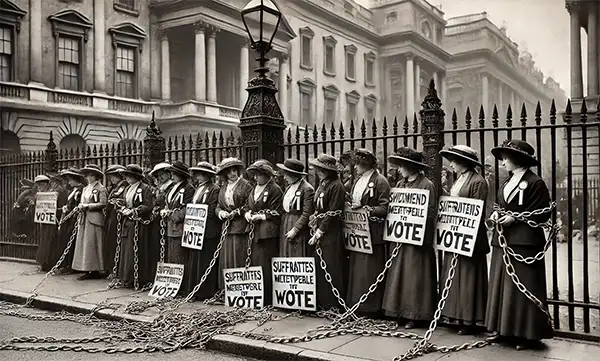Celebrating the Suffragette Movement
Emmeline Pankhurst Day, celebrated on July 14th, honors the legacy of one of the most influential leaders in the fight for women's suffrage. Emmeline Pankhurst, born on this day in 1858, was a formidable force in the suffragette movement, advocating tirelessly for women's right to vote in the United Kingdom. Her dedication, courage, and unyielding spirit played a crucial role in achieving gender equality. Let's delve into the history and significance of the suffragette movement and the indomitable woman who led it.
The Birth of the Suffragette Movement
The suffragette movement emerged in the late 19th and early 20th centuries as women across the world began to demand their right to participate in the democratic process. In the UK, the movement gained momentum with the establishment of the Women's Social and Political Union (WSPU) in 1903 by Emmeline Pankhurst and her daughters, Christabel and Sylvia. The WSPU's motto, "Deeds, not words," encapsulated their approach: they believed in taking direct action to achieve their goals.
The Pankhurst Family: Emmeline Pankhurst was born into a politically active family. Her parents were supporters of women's suffrage, and she was exposed to progressive ideas from an early age. Married to Richard Pankhurst, a lawyer who championed women's rights, Emmeline was deeply involved in political activism. After Richard's death, she continued their shared mission with renewed vigor, driven by a passion for justice and equality.
 The Fight for the Vote
The Fight for the Vote
The WSPU adopted more militant tactics than their predecessors, believing that peaceful protests were insufficient. Suffragettes organized rallies, disrupted political meetings, and even engaged in acts of civil disobedience. They smashed windows, set fires, and chained themselves to railings—all to draw attention to their cause. While these methods were controversial and often led to arrests, they succeeded in keeping women's suffrage in the public eye.
Hunger Strikes and Force-Feeding: Imprisoned suffragettes often went on hunger strikes to protest their incarceration. The government's response was brutal: they resorted to force-feeding, a painful and dangerous procedure that sparked public outrage. The image of frail women being forcibly fed highlighted the lengths to which these women were willing to go for their rights, further galvanizing support for the movement.
The Role of World War I
World War I marked a turning point for the suffragette movement. As men went to war, women stepped into roles traditionally held by men, proving their capability and indispensability. This shift in societal roles bolstered the argument for women's suffrage. Recognizing their contributions, the Representation of the People Act 1918 was passed, granting the vote to women over the age of 30 who met minimum property requirements. It wasn't until 1928 that women gained equal voting rights with men.
Emmeline Pankhurst's unwavering dedication to the suffragette cause made her a symbol of courage and determination. Despite facing imprisonment, violence, and public scorn, she remained steadfast in her fight for equality. Her leadership inspired countless women to join the movement and demand their rights. Pankhurst's legacy is a testament to the power of perseverance and the impact one individual can have on the course of history.
Celebrating Emmeline Pankhurst Day
Emmeline Pankhurst Day is an opportunity to reflect on the progress made in the fight for gender equality and to honor the women who paved the way. Here are some meaningful ways to celebrate this day:
-
Learn and Educate: Read about the suffragette movement and Emmeline Pankhurst's contributions. Share their stories with others to raise awareness about the history of women's rights.
-
Visit Historical Sites: Explore museums and historical sites related to the suffragette movement. Many places offer exhibits and tours that provide deeper insights into this pivotal period.
-
Support Women's Rights Organizations: Donate to organizations that continue to fight for gender equality. Your support can help further the cause that Pankhurst and her fellow suffragettes championed.
-
Engage in Activism: Participate in events and activities that promote women's rights. Whether it's attending a rally, joining a discussion panel, or volunteering, your involvement can make a difference.
-
Reflect and Advocate: Take a moment to reflect on the progress made and the work that still needs to be done. Advocate for policies and initiatives that promote gender equality in all spheres of life.
While the suffragette movement was a serious and often dangerous endeavor, it's worth noting that these trailblazing women also had a sense of humor. They used wit and satire to make their points, often turning the tables on their detractors. Imagine a suffragette tea party with cups labeled "Votes for Women" and biscuits shaped like ballots—proving that even in the face of adversity, they never lost their spirit or sense of fun.
Emmeline Pankhurst Day is a celebration of resilience, courage, and the relentless pursuit of equality. The suffragette movement, led by extraordinary women like Pankhurst, reshaped the political landscape and secured a future where women's voices could be heard. As we honor their legacy, we are reminded that the fight for gender equality is far from over. By continuing to educate, advocate, and support, we can carry forward the spirit of the suffragettes and work towards a more just and equal society.
Please Share our Content






 The Fight for the Vote
The Fight for the Vote








 "Sláinte!" is a traditional Irish expression used as a toast, equivalent to "Cheers!" in English.
"Sláinte!" is a traditional Irish expression used as a toast, equivalent to "Cheers!" in English.